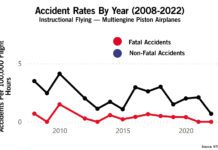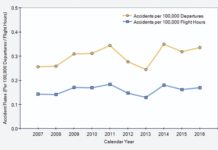The airplane collided nose-down onto a taxiway at 1805 Eastern time, shortly after takeoff. The flight instructor, a commercial pilot and two passengers were killed, and the airplane was destroyed. There was a post-crash fire. During initial climb, the flight instructor told ATC they had an engine failure and “needed to turn-around and land.” The controller cleared the flight to land “any runway” and there was no further communications with the flight. A poor-quality security video showed the accident airplane taking off, climbing and starting a slow turn to the left. The accident airplane continued to turn left until a large explosion was observed. Investigation revealed the left wings fuel cap was in place and fuel remained in the fuel tank. No fuel was found from the fuel selector valve forward to the engine-driven fuel pump. The left fuel selector valve was found in the off position and the right fuel selector valve was found in the on position. Fuel control continuity was established from the fuel levers in the cockpit to the fuel selector valves. The left propeller was not in the feathered position and no evidence of any pre-impact mechanical failure or malfunction of the left engine was found.



